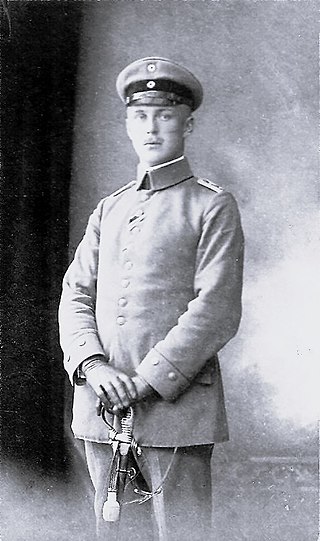Feldwebel is a non-commissioned officer (NCO) rank in several countries. The rank originated in Germany, and is also used in Switzerland, Finland, Sweden, and Estonia. The rank has also been used in Russia, Austria-Hungary, occupied Serbia and Bulgaria.
Unteroffizier is a junior non-commissioned officer rank used by the Bundeswehr. It is also the collective name for all non-commissioned officers in Austria and Germany. It was formerly a rank in the Imperial Russian Army.

Unteroffizier(e) mit Portepee, also Portepeeunteroffizier(e) (transl. Non-commissioned officer(s) with sword knot), is the designation for German senior non-commissioned officers in the armed forces of Germany. The title derives from the French porte-épée ("sword bearer"), as senior enlisted men would historically carry a sword into battle.
Fähnrich zur See designates in the German Navy of the Bundeswehr a military person or member of the armed forces with the second highest Officer Aspirant rank. According to the salary class it is equivalent to the Portepeeunteroffizier ranks Bootsmann (Marine) and Feldwebel of Heer or Luftwaffe.
Seekadett is a military rank of the Bundeswehr and of former German-speaking naval forces.
Generalstabsarzt and Admiralstabsarzt are in the German armed forces the rank designations of the second highest grade of the generals rank group.
Oberstarzt (OTA) is a military rank in German speaking armed forces. It denotes a medical staff officer surgeon or medical staff officer dentist and is comparable to Colonel (de: Oberst) or Captain (naval) (de: Kapitän zur See) NATO-Rangcode OF5 in anglophone armed forces.
The rank insignia of the federal armed forces of the Federal Republic of Germany indicate rank and branch of service in the German Army, German Air Force, or the German Navy.
Oberfähnrich zur See designates in the German Navy of the Bundeswehr a military person or member of the armed forces with the last or highest Officer Aspirant rank. According to the salary class it is equivalent to the Portepeeunteroffizier ranks Hauptbootsmann (Marine) and Hauptfeldwebel of Heer or Luftwaffe.
Oberstabsarzt is a military rank in German speaking armed force. It describes a medical staff officer surgeon or medical staff officer dentist comparable to major or lieutenant commander NATO-Rangcode OF3 in anglophone armed forces.
Oberfähnrich designates in the Heer of the Bundeswehr a military person or member of the armed forces with the last or highest Officer Aspirant rank. According to the salary class it is equivalent to the Portepeeunteroffizier ranks Hauptfeldwebel of Heer or Luftwaffe, and Hauptbootsmann of Marine.
Generaloberstabsarzt and Admiraloberstabsarzt are the top Joint Medical Service OF8-ranks of the German Bundeswehr. The equivalent to this ranks in the Heer is Generalleutnant and in the German Navy the Vizeadmiral.
Generalarzt is the designation of a military rank as well as the official title in German speaking armed forces. It is equivalent to the Admiralarzt / Generalapotheker and Brigadegeneral / Flottillenadmiral.
Oberfeldarzt is a military rank in German speaking armed forces. It denotes a medical staff officer surgeon or medical staff officer dentist and is comparable in rank to lieutenant colonel or (naval) commander NATO-Rangcode OF4 in anglophone armed forces.
Stabsarzt, in English Staff Surgeon, is a military commissioned officer rank in German speaking armed forces. In the German Bundeswehr and the former Wehrmacht and Reichswehr, it describes a qualified or licensed surgeon or dentist who practises military medicine, with a rank equal to captain in the army and the air force or lieutenant in the navy. In the Austrian and Swiss armies, the rank is Hauptmann.

Oberarzt, literally meaning "senior physician," in English known as first lieutenant (Dr.), was a military commissioned officer rank in the Austro-Hungarian Common Army until 1918, and in the German Reichswehr and Wehrmacht until 1945.
Assitenzarzt was a military rank in the Austrian-Hungary Common Army until 1918 and in German Reichswehr and Wehrmacht until 1945.
Hauptbootsmann designates in the German Navy of the Bundeswehr a military person or member of the armed forces. It belongs to the particular rank group Senior NCOs with port épée.
Oberbootsmann designates in the German Navy of the Bundeswehr a military person or member of the armed forces. It belongs to the particular rank group Senior NCOs with port epée.
Feldunterarzt was a military rank in the German Wehrmacht until 1945. It was established additional to the Unterarzt July 25, 1940. Uniform and shoulder board were identical to the Fahnenjunker-Oberfeldwebel (Oberfähnrich), however without the double unterofficer galloons. The Gothic letter A between the two silver felwebel stars indicated the membership to the Military Medical Academy in Berlin. The Feldunterarzt was an officer aspirant in the Military Health Service.



